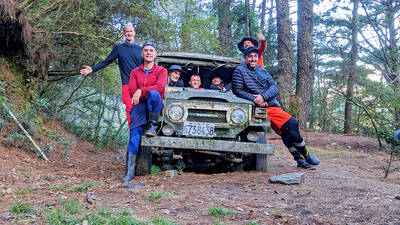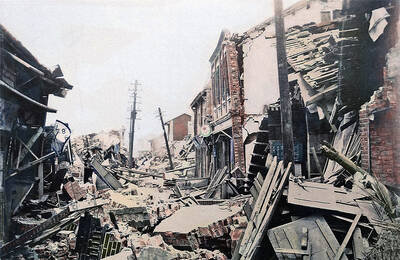Having spent 13 years studying French and Italian cuisines in Vienna, there's hardly any dish that Hong Chang-wei (
A college restaurant management lecturer in the daytime, the chef and owner of Sowieso maintains gourmet-standard cuisine at his restaurant, as well as introducing Italian dishes rarely available here.
When Hong returned to Taiwan from learning his trade in Austria and Italy nine years ago, he set up one of the few Taipei restaurants that offered more kinds of pastas than spaghetti.

PHOTO: VICO LEE, TAIPEI TIMES
Hong's love for Italian cuisine was born from his first savoring of spaghetti with peppers and garlic in Vienna. "Before I went to Vienna, like most people in Taiwan at the time, my idea of pasta was nothing more than spaghetti with pork and sauce. The spaghetti with peppers and garlic made me understand the essence of good Italian cuisine. The noodles were bouncy and the olive oil wrapped around the noodles so closely it became one. Also the garlic slices blended into the oil, so that the fragrance lingered," Hong recounted.
"Italian cooking is very similar to Chinese cooking. There's sauteeing, stir-frying, boiling and stewing. The preparations of ingredients are also similar," Hong said.
Hong's version of spaghetti with peppers and garlic (spaghetti alio e olio, NT$280) is made with basil leaves and chili peppers. It is slightly different from the authentic version, not to create a localized flavor, but to improve the fragrance and flavor. It's mainly the foreign customers, Hong said, who most fully appreciate the restaurant's authentic cooking style. Osso bucco alla milanese with fettuccine (NT$680) is their favorite, he said.
Apart from using quality ingredients, Hong said the secret of good cooking was often the use of spices and treatment of ingredients before they are cooked. Simple ingredients can also work magic if prepared right, Hong said. The pumpkin soup, for example, acquires a delightful color and aroma after the pumpkins are left to ripen for a few days to bring out their sweetness.
Wines are Sowieso's forte. The restaurant has a regular stock of over 60 kinds of wines from seven countries, mostly Italy, France and Spain. Hong chose Farnese's 2000 Chardonnay to go with the spaghetti, peppers and garlic. For the fettuccine he selected Masi's Amarone 1997.

The year was 1991. A Toyota Land Cruiser set out on a 67km journey up the Junda Forest Road (郡大林道) toward an old loggers’ camp, at which point the hikers inside would get out and begin their ascent of Jade Mountain (玉山). Little did they know, they would be the last group of hikers to ever enjoy this shortcut into the mountains. An approaching typhoon soon wiped out the road behind them, trapping the vehicle on the mountain and forever changing the approach to Jade Mountain. THE CONTEMPORARY ROUTE Nowadays, the approach to Jade Mountain from the north side takes an

Last week Joseph Nye, the well-known China scholar, wrote on the Australian Strategic Policy Institute’s website about how war over Taiwan might be averted. He noted that years ago he was on a team that met with then-president Chen Shui-bian (陳水扁), “whose previous ‘unofficial’ visit to the US had caused a crisis in which China fired missiles into the sea and the US deployed carriers off the coast of Taiwan.” Yes, that’s right, mighty Chen caused that crisis all by himself. Neither the US nor the People’s Republic of China (PRC) exercised any agency. Nye then nostalgically invoked the comical specter

Relations between Taiwan and the Czech Republic have flourished in recent years. However, not everyone is pleased about the growing friendship between the two countries. Last month, an incident involving a Chinese diplomat tailing the car of vice president-elect Hsiao Bi-khim (蕭美琴) in Prague, drew public attention to the People’s Republic of China’s (PRC) operations to undermine Taiwan overseas. The trip was not Hsiao’s first visit to the Central European country. It was meant to be low-key, a chance to meet with local academics and politicians, until her police escort noticed a car was tailing her through the Czech capital. The

April 15 to April 21 Yang Kui (楊逵) was horrified as he drove past trucks, oxcarts and trolleys loaded with coffins on his way to Tuntzechiao (屯子腳), which he heard had been completely destroyed. The friend he came to check on was safe, but most residents were suffering in the town hit the hardest by the 7.1-magnitude Hsinchu-Taichung Earthquake on April 21, 1935. It remains the deadliest in Taiwan’s recorded history, claiming around 3,300 lives and injuring nearly 12,000. The disaster completely flattened roughly 18,000 houses and damaged countless more. The social activist and